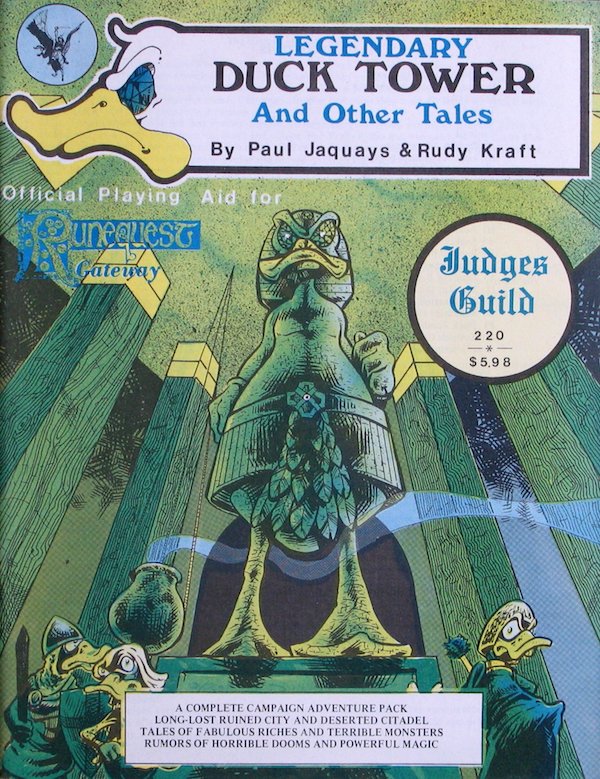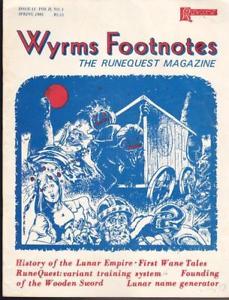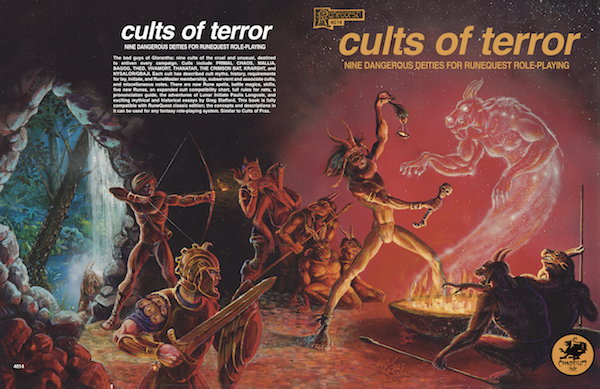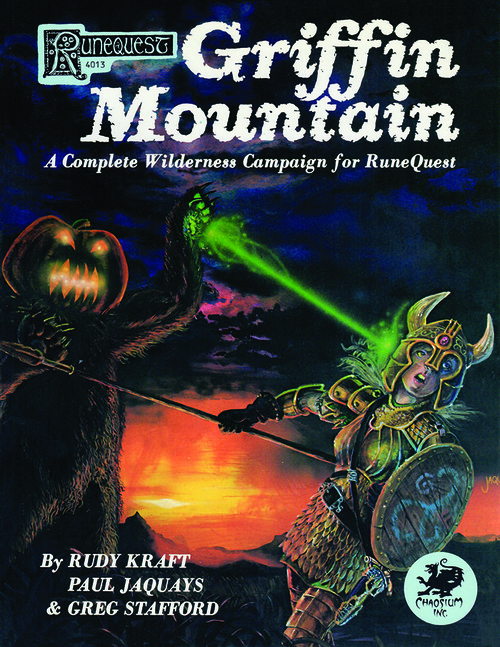Women in Tabletop Gaming Month #15: Chaosium interviews Jennell Jaquays
Posted by Michael O'Brien on 20th Jun 2018
Lynne Hardy interviews RPG pioneer and GAMA Hall of Famer Jennell Jaquays for Women in Tabletop Gaming Month
Serious ones first:
1. What is your background?
I went to a small liberal arts college straight out of high school, testing out of (nearly all) my freshman year (except writing—go figure). It still took me four years to get my Bachelor of Arts degree, and a major in art. (Though, by the number of art credits I took, I would have had both a major and a minor in art.) I took a LOT of art classes, mostly studio of various kinds: drawing, painting, sculpture, print making, calligraphy—even typography. And I passed that freshman writing course and took more courses in writing and understanding popular fiction (I veered off from an English minor because it focused on churning out English teachers, and I had no desire to become a teacher). But I was able to get credit and recognition for several gaming-related projects I worked on (outside of class), earning me the schools’ award for diverse experience in the humanities when I graduated.
First job might be radio announcer. I went to work for the college FM station as an announcer (after getting my 3rd class radio operator’s license) and then spent a bit more than a year as the station’s program director. It was an interesting experience, but my tentative attempts to do it outside of college convinced me this was not a career I wanted.
My first job after college was doing graphic design and pasteup for a quick print shop near where I lived. (This was well before the era of desktop publishing.) That ended after only a few weeks—roadwork outside the shop that lasted for months killed nearly all the walk-in traffic, and my job with it.
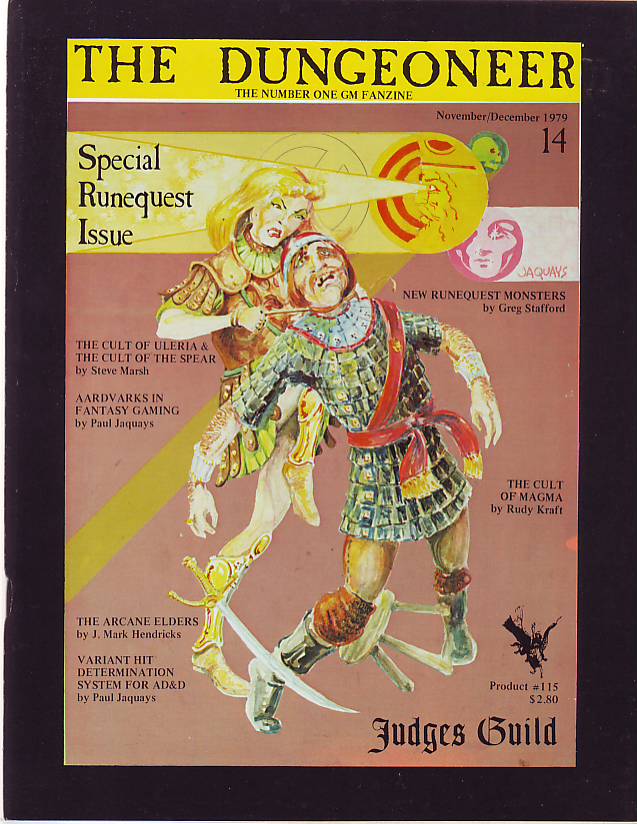 Not long after that, a personal connection
through adventure gaming fandom led me to Judges Guild, the first company
licensed to create adventures and accessories for Dungeons & Dragons. I interviewed with them and landed my first
job in gaming as a game adventure designer, developer, and illustrator for D&D adventures and accessories. But
they weren’t the first company I had interviewed with that year. Earlier, a
company in Texas had decided that instead of hiring me, they would hire a
secretary instead.
Not long after that, a personal connection
through adventure gaming fandom led me to Judges Guild, the first company
licensed to create adventures and accessories for Dungeons & Dragons. I interviewed with them and landed my first
job in gaming as a game adventure designer, developer, and illustrator for D&D adventures and accessories. But
they weren’t the first company I had interviewed with that year. Earlier, a
company in Texas had decided that instead of hiring me, they would hire a
secretary instead.
2. How long have you been gaming? What attracted you to it in the first place, and how were you introduced to it?
I’ve been playing and making my own games since I was a pre-teen. My younger brother, Bruce, and I used to build worlds, space ships, and battle grounds for our plastic armies out of wooden blocks, other toys, and scrap paper (the back side of test papers from our teacher grandparents and discarded photocopies from our dad’s office). We enjoyed playing Milton Bradley’s Heritage series of mass market wargames and often munged them together into single game experiences. That led to making our own “board games” by gluing scrap paper sheets edge to edge to create the game boards. One, based on my memories of the Kirk Douglas/Sidney Poitier movie, The Long Ships (Cardiff, 1964), covered the entire floor of our bedroom. Rules were simple: roll dice, experience the hazards of exploring the world in a Viking long ship by moving tokens along a track, using limited decision points in hopes of making it back home (Start). Later we created simple fire and movement rules for our (vast) armies of 1/72nd scale Airfix figures. My brother often won. He could “do things” to dice that made them come up with the numbers needed to knock down more of my soldiers than I knocked down of his.
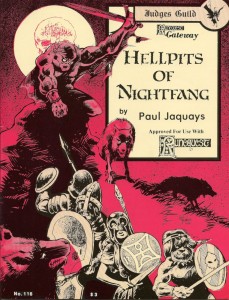 And yet, Bruce turned out to be the gamer.
I was more interested in comic books and had a hope of working in that industry
someday.
And yet, Bruce turned out to be the gamer.
I was more interested in comic books and had a hope of working in that industry
someday.
Years later, in college, my brother called me at the radio station while I was working and read me reviews that he had found in a magazine a publisher had sent to him because he subscribed to another war game publication. The reviews described this strange game called Dungeons & Dragons. As I listened, I was hooked. Looking back, that moment was one of those times where you can almost sense your life changing. My world had shifted, and literally stopped going in one direction and began to move in another, one that would lead me into working in games.
3. How did you get into the gaming industry?
I started by submitting unsolicited art to game magazines like The Space Gamer (where those first reviews of Dungeons & Dragons were discovered) and then Dragon magazine (I have work in the first issue). I got things moving by creating and publishing a D&D fan magazine called The Dungeoneer. That led to illustrating game products freelance for Metagaming Concepts and Martian Metals, and then to working full-time as an artist and adventure designer for Judges Guild in 1978 after I graduated from college.
I later went on to work with Chaosium on a few RuneQuest projects. But before Chaosium, I designed two adventure settings, and wrote a few articles for game periodicals with additional content for the game. The first of those adventures was The Hellpits of Nightfang, a rather racy title for the late ’70s. The adventure had the player characters exploring into some deep sinkholes, looking for what might be a vampire. The second, and more famous of the two, was Duck Tower, whose cover was a visual pastiche on my cover for Dark Tower, my first commercial game adventure. The statues and adventurers had been replaced by duck versions. While the cover may have been a bit silly, the adventure was a serious exploration of marsh-flooded ruins, using a flexible encounter system. (None of the creatures or characters in the adventure were in fixed locations—the game master decided where and when the encounters would be placed.) However, I left that adventure unfinished when I left Judges Guild after a year. Rudy Kraft would come in and finish the setting using my maps and original notes.
The collaboration worked and Rudy approached me to finish a RuneQuest project that he had started for Judges Guild: a Gateway-branded adventure setting called Adventures Beyond the Pass. I fleshed out his encounter stats and turned them into characters, created a few memorable encounters myself, drew up a cover, created a logo for it and began to prep the module for publication. Somewhere in the process, Greg Stafford got wind of our project and wanted it to be a part of Glorantha. From that, Griffin Mountain was born.
My original cover art for Adventures Beyond the Pass gave away the big reveal of one of the encounters in Griffin Mountain, so it wasn’t used in the final book. But it did appear later as a Wyrm’s Footnotes cover (one of the two that I did for the magazine).
Around the same time, Chaosium approached me to be a contributor to Cults of Terror, the book of Chaos cults. I created the headhunter cult of Thanatar, painted the cover, and drew many of the interior illustrations. It was my first wrap-around painting and one of the few paintings I still have in my possession from my illustration career.
I went on to add some additional material that would be included in Griffin Island, the Avalon Hill version of the setting. Some of the work that I did that was rejected for that book later found its way into the mythology and world setting of TSR’s Forgotten Realms campaign as the Uthgardt barbarians.
4. What was the first gaming product you worked on, and in what capacity?
My first gaming product was The Dungeoneer magazine in the summer of 1976, a half-size D&D fanzine that I created and produced with my college gaming group. The first issue was 12 pages. I was publisher, author, editor, and artist on that. The adventure in that magazine, “F’Chelrak’s Tomb,” also turned out to be the second standalone D&D adventure ever published (missed first place by two weeks). My first gaming product where I worked for someone else was the micro game Chitin: I—The Harvest Wars for Metagaming Concepts in 1977. I was the artist for that game, designing the game logo, and doing the cover art, interior illustrations, and playing piece icons.
5. What was the last gaming product you worked on, and in what capacity?
My last published project was in 2017: “The Dragon’s Secret,” a 40-page Swords & Wizardry Complete adventure included in the Legends of Adventure, an omnibus of work by former TSR staff. The book’s proceeds were used to raise money to cover medical expenses for the founder of North Texas RPG Con (and support the convention itself). I was designer, editor, cartographer, illustrator, and page production for my contribution to that book. Currently, I have several similar projects in process, including an updated, stand-alone version of “The Dragon’s Secret” and Quack Keep, a system agnostic adventure setting being created as part of a recent Star Hat Miniatures Kickstarter that featured ducks. I’m at the production stage on Quack Keep, hoping to ship by the end of May.
6. What has been the most challenging gaming product you’ve worked on, and why? (Alternatively, this could be the gaming product you’ve learned the most from working on)
It may be a game adventure called Talons of Night that I wrote for TSR’s Master-level Dungeons & Dragons rules back in the late 80s. I wasn’t originally assigned this project. If memory serves, I was brought in because the original designer was unavailable. I had been away from tabletop gaming work for nearly six years by then (I had shifted gears to work in electronic and video games until the crash in the mid-80s). Up until that point, I had been doing mostly editorial and development work for TSR for about a year, including contributing as an editor on an earlier title in the Master series. I didn’t have much experience creating new adventures for D&D characters of this high level (level 30-35). To top it all off, the cover art prototype in the catalog was indecipherable and the description of what needed to happen in the adventure so vague that I can’t even remember it, except that it involved the leaders of two massive countries in the D&D world that had recently appeared in one of the last Gazetteer products.
I needed to create a story, develop an
entirely new section of the D&D
Known World, use the D&D Battlesystem
army combat rules, challenge both the high-level characters and their players (who probably had more
experience in the game than I did), and do it all in 48 pages. Oh, and
roleplaying. The game’s epilogue (if the players are successful) involves the
players roleplaying as the leaders of warring nations. Their goal is to satisfy
both their national interests and
somehow achieve a lasting peace (or, at least, one that lasts 1d6 years).
Apparently, I pulled it off, and it’s considered one of the more epic (several reviewers’
word for it) and unusual adventures in the series. What have I learned? Scope
is important. And I had badly over-scoped this one for the amount of space that
I had available to me in the game book. I wanted to get so much into it. And I
did manage to get in all the major beats for the adventure, but some are
described extremely sketchily. Did I
mention that most of the encounters are tied together by a simple board game
based on Nine Men’s Morris?
7. What has been the most enjoyable/rewarding gaming product you’ve worked on, and why?
Enjoyable… Possibly my Central Casting series of books about creating character histories. It’s rare that a designer has full ownership of the projects they create. Central Casting had been a pet project since my earliest days of gaming in college. I played around with it for over ten years. The first book in the series about fantasy characters saw print nearly 30 years ago, followed by two more books (science fiction, and modern-day characters). The publisher went out of business nearly 20 years ago and the rights reverted to me. Time for an update, I think. Rewarding? Oddly, it may be The Dungeoneer magazines I did in college. They created the foundation for a career making games. How cool is that?
 And now for some more frivolous ones:
And now for some more frivolous ones:
8. Just how large is your dice and/or stationary collection?
Probably not as large as some might imagine. I think I can get all my dice in a two-quart container (OK, maybe not if you include dice from board games). I still have my first dice, my vintage 1975 chip-tastic D&D dice which rounded their own corners as you played, flecking off tiny bits of fragile plastic over the years. I almost lost the entire collection when my son went off to college and took my dice with him. They were abandoned in his dorm room (along with a lot of other gaming stuff) after his first year at school. One of his room-mates salvaged them and eventually returned them to me. I’ve only added a few since then, including my now much-prized rainbow dice (each die is striped with rainbow colors).
9. What is your favourite gaming snack?
Back in the day, it was Mountain Dew and Doritos. These days, I’ll go with Coke Zero and perhaps cheese and multi-grain crackers. Those Doritos (and Cheetos) left their mark too easily on my game books of yore.
10. What’s the most unusual/exotic location you’ve gamed in? Or that one of your games has been played in?
I’m a boring gamer, so not a lot in the way of exotic in my life. We once played D&D in a stairwell of my college’s Physical Education Center. I can’t really remember why—I think one of the guys was dating a girl who was attending an event there that weekend and he wanted to connect with her later that evening. Though I did meet one of her friends, who became a future girlfriend of mine that night in the stairwell. Though not exotic, I played in an official AD&D tournament at Gen Con in Lake Geneva in 1977. We played in the sheltered outdoor area around a garden while rain poured down next to us. Later that weekend, we happened to be playing in an upstairs hallway at the Playboy club (where the dealer’s room was located) and Gary Gygax and author Fritz Leiber walked by. I didn’t say anything, but that was really a geek-out celebrity encounter moment for me (Fritz Leiber… and maybe Gary, a little bit).
Biography:
Jennell Jaquays pioneered pre-made RPG scenarios in her D&D fanzine The Dungeoneer in 1976 and is still known for her adventures Dark Tower and Caverns of Thracia from Judges Guild. She assembled one of the first video game art and design studios at Coleco to make ColecoVision games. After working as an RPG artist and designer and then staff artist for TSR, the original publisher of Dungeons & Dragons, she returned to computer games in 1997 as a designer for id Software’s Quake 2 and 3 games, as an artist for Age of Empires and Halo Wars titles, and as a co-founder of The SMU Guildhall in Dallas, a leading video game development school. In 2012, Jennell co-founded and served as Chief Creative Officer for Olde Sküül, Inc. in Seattle, WA. She has since returned to developing RPG content and art as Dragongirl Studios. She was a 2017 inductee into the Adventure Gaming Arts and Design Hall of Fame. Her current project, Quack Keep, with Darcy Perry of Star Hat Miniatures, will be published in 2018. Answer content © 2018 Jennell Jaquays.

